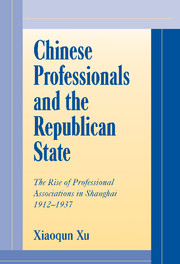 Chinese Professionals and the Republican State
Chinese Professionals and the Republican State Published online by Cambridge University Press: 07 September 2009
THE MEDICAL profession in twentieth-century China comprised two major schools: native medicine and Western medicine. The difference between native and Western medicine in philosophy, theory, and technique made a conflict between the two schools almost inevitable, and the conflict was intensified during the Republican period when the professionalization process brought their differences into sharp focus. Chinese practitioners of Western medicine advocated national salvation through science and dismissed native medicine as superstitious, unscientific, and an impediment to the development of medical science in China. On the other hand, native medical practitioners insisted that what they learned and practiced was part of the national essence (guocui) and should be protected against the cultural invasion of imperialism (diguo zhuyi wenhua qinlue), including Western medicine. Both sides used such rhetoric to camouflage the business competition between them, but the rivalry and its implications did point to a cultural conflict between Chinese tradition and Western influence in China's modernization, as Ralph C. Croizier's study pointed out long ago. More recently, studies by Ruth Rogaski and Bridie J. Andrews show how Western medicine was adopted by the state (at the municipal level) as part of the modernization project and how it competed against and negotiated with native medicine in the Republican era.
To save this book to your Kindle, first ensure no-reply@cambridge.org is added to your Approved Personal Document E-mail List under your Personal Document Settings on the Manage Your Content and Devices page of your Amazon account. Then enter the ‘name’ part of your Kindle email address below. Find out more about saving to your Kindle.
Note you can select to save to either the @free.kindle.com or @kindle.com variations. ‘@free.kindle.com’ emails are free but can only be saved to your device when it is connected to wi-fi. ‘@kindle.com’ emails can be delivered even when you are not connected to wi-fi, but note that service fees apply.
Find out more about the Kindle Personal Document Service.
To save content items to your account, please confirm that you agree to abide by our usage policies. If this is the first time you use this feature, you will be asked to authorise Cambridge Core to connect with your account. Find out more about saving content to Dropbox.
To save content items to your account, please confirm that you agree to abide by our usage policies. If this is the first time you use this feature, you will be asked to authorise Cambridge Core to connect with your account. Find out more about saving content to Google Drive.